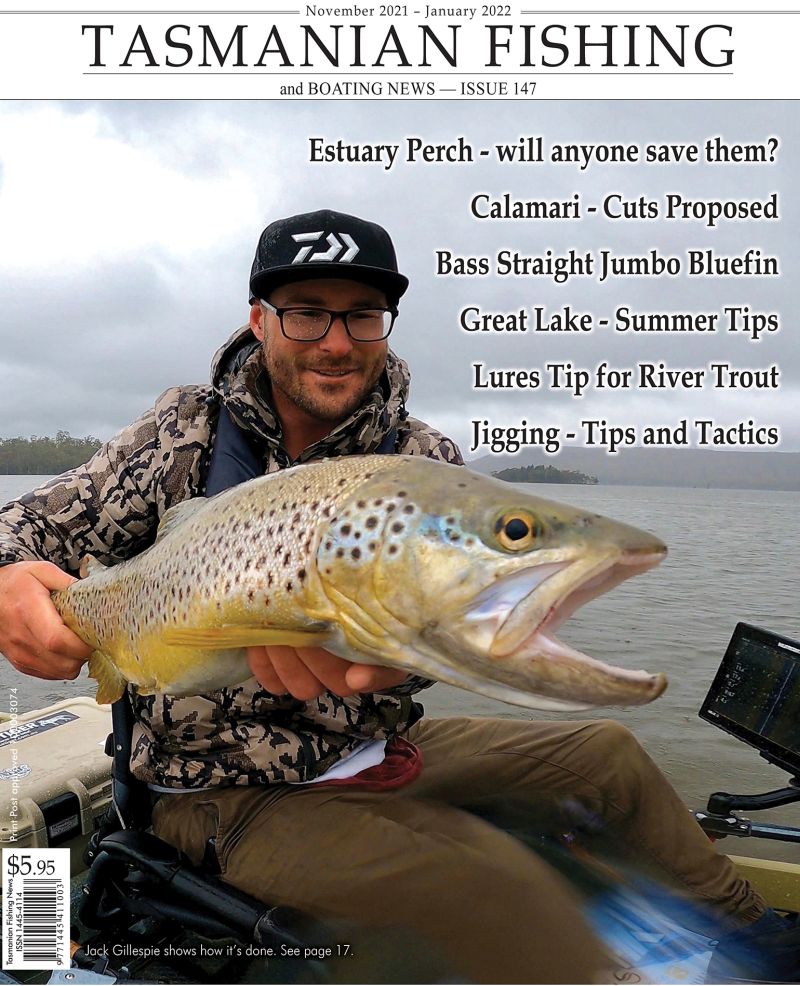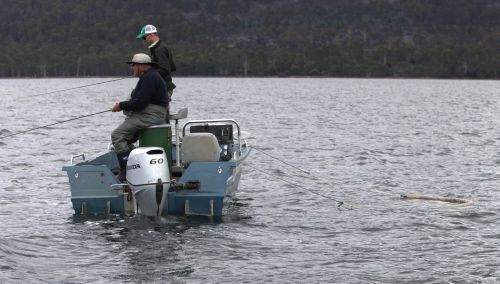Targeting Striped Trumpeter
Professional Charter operator, Rocky Carosi looks at one of Tasmania's most sought after fish - Striped Trumpeter (Latris lineata)
Fact file: Striped Trumpeter are distributed from Sydney to Kangaroo Island and of course all around Tasmania. They are found also in New Zealand and South American waters. In Tasmania they spawn from late Winter to early Spring. Stripey trumpeter grow at least 1.2 m in length and 25 kg in weight. The Tasmanian Striped Trumpeter has five-star qualities as well as five-star fighting abilities.
Tasmania's East Coast provides many shallow coastal reefs as well as deep offshore waters where the "Stripey" lives The shallow coastal reefs appear to mainly be inhabited by juvenile fish (average 5kg) in smaller numbers. The deeper offshore waters seem to hold the larger fish (10-25kg) in larger numbers. The Tasmanian Striped Trumpeter is a mighty fish and its impressive qualities make it the ultimate challenge for those fishermen chasing bottom-fishing species around Tasmania. As mentioned, the inshore coastal reefs mainly produce juvenile fish and they can be elusive, which is part of the challenge of hooking them.
A lot of mystery still seems to surround the Striped Trumpeter, probably because in the past it has not commonly been caught by the greater percentage of recreational fishermen. Several factors need to go together to give the best chance of having a successful Stripey fishing trip.
Tackle and Bait
Good quality spinning reels are my personal preference. We run Penn Spinfisher and Shimano Speedmaster on our Charter boat - fairly high retrieve ratios, very reliable, with smooth running drag systems. It is worth stressing, especially for this type of powerful fish in the saltwater environment, there is no substitute for having a good quality reel. The few extra dollars spent will be well worth it. The new braided lines have revolutionised out bottom fishing and are a definite advantage when it comes to detecting the bites in deep water or in a fairly strong current.
Our reels are spooled with 10kg Dacron which is slightly thicker than 10 kg monofilament. The 6-15 kg breaking strain is ideal. The choice us to fill the spool with the braided line or to top shot say 150 m onto your monofilament which fills the remainder of the spool. It is worth nothing that the use of these non-stretch braided lines determines that the eyes on the rod and the quality of the reel's drag system must be good. An uneven drag will cause the line to break, plus the fine diameter line can cut into poor quality eyes on the rod.
My favourite bait is octopus, which I put in boiling water for a minute to make peeling the skin off easier. Small portions are put in bags and then into the freezer. Other good baits include squid, tuna and gurnard - the fresher often the better. Bait jigs or flies will also catch stripeys, the only downfall is that some off the shelf bait jigs do not always have a strong enough hook or trace. Making your own bait jigs is a good option using some of the different coloured fish hairs and trout fly tying gear available. A 4/0-5/0 stainless steel hook with 50-100lb monofilament trace is suitable. One other essential piece of equipment is either a very sharp but small gaff hook or landing net, as many fish are lost at the surface once all the hard work has been done. (Just released are the new Black Magic jigs. These should be excellent. Ed.)
Location and time
The Striped Trumpeter form schools and inhabit rocky ledges, drop-offs and reefs in water depths that are greatly varied (15-250m) The direction in which the tide and current are running will determine on which side of the reef the fish will be sitting, which is usually the area where the current takes the feed to the fish. We find the schools tend to move around quite a lot. There is no substitute for having a good echo sounder which you must subject to massive experimentation until you can select the best screen that you can follow. Koden make a small colour sounder which is ideal for powerboats and reading the bottom to around 300 metres. In light wind conditions drifting is an option which allows a large area of reef to be covered and once the sand is reached, the boat can be repositioned to recommence the drift. As the wind increases or tidal movement is fierce, a good anchoring system is required - 250 m of rope connected to a reef anchor is sufficient. In certain conditions, if you know the fish are on a certain side of the reef, a sand anchor may be required to allow the boat to be positioned over the fish. The Stripey is about all year round, but Winter-Spring is certainly the most productive time to fish. As the tide slackens there seems to be an urgency as the bite increases. Any fish kept for eating should be bled, cleaned quickly and put on ice. They are my favourite eating fish and are nothing short of sensational when fresh. Any fish not needed can be carefully de-hooked and released.
Productive Stripey fishing areas out of St Helens include Pulfers Reef, Merricks Reef, St Helens Island, Eddystone and the Continental Shelf drop-off.
The Tasmanian Striped Trumpeter is impressive-looking, hard-fighting and sensational eating! What a fish! Are you good enough to outsmart the mighty Stripey?
Rocky Carosi operates Professional Charters at St Helens specialising in Striped Trumpeter and Reef Fishing trips, plus Game fishing from January to May. Ph (03) 63763083 or 0149 383 362.



